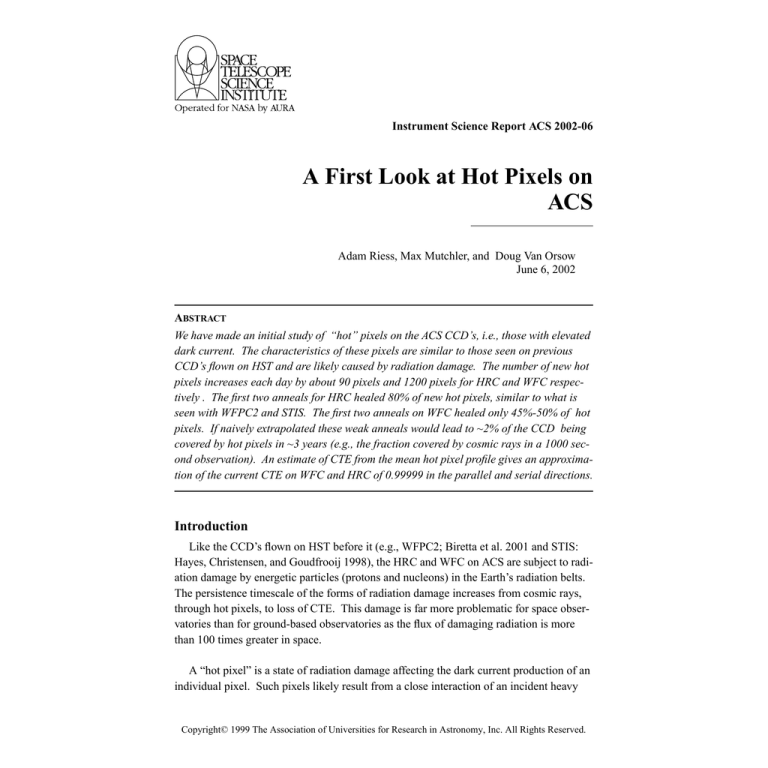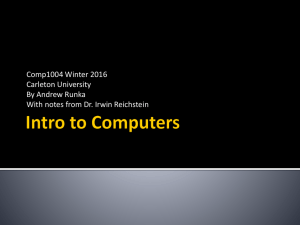
Instrument Science Report ACS 2002-06
A First Look at Hot Pixels on
ACS
Adam Riess, Max Mutchler, and Doug Van Orsow
June 6, 2002
ABSTRACT
We have made an initial study of “hot” pixels on the ACS CCD’s, i.e., those with elevated
dark current. The characteristics of these pixels are similar to those seen on previous
CCD’s flown on HST and are likely caused by radiation damage. The number of new hot
pixels increases each day by about 90 pixels and 1200 pixels for HRC and WFC respectively . The first two anneals for HRC healed 80% of new hot pixels, similar to what is
seen with WFPC2 and STIS. The first two anneals on WFC healed only 45%-50% of hot
pixels. If naively extrapolated these weak anneals would lead to ~2% of the CCD being
covered by hot pixels in ~3 years (e.g., the fraction covered by cosmic rays in a 1000 second observation). An estimate of CTE from the mean hot pixel profile gives an approximation of the current CTE on WFC and HRC of 0.99999 in the parallel and serial directions.
Introduction
Like the CCD’s flown on HST before it (e.g., WFPC2; Biretta et al. 2001 and STIS:
Hayes, Christensen, and Goudfrooij 1998), the HRC and WFC on ACS are subject to radiation damage by energetic particles (protons and nucleons) in the Earth’s radiation belts.
The persistence timescale of the forms of radiation damage increases from cosmic rays,
through hot pixels, to loss of CTE. This damage is far more problematic for space observatories than for ground-based observatories as the flux of damaging radiation is more
than 100 times greater in space.
A “hot pixel” is a state of radiation damage affecting the dark current production of an
individual pixel. Such pixels likely result from a close interaction of an incident heavy
Copyright© 1999 The Association of Universities for Research in Astronomy, Inc. All Rights Reserved.
Instrument Science Report ACS 2002-06
nucleon with Si nuclei in a pixel creating new Si-SiO2 interface states. Once produced
such pixels almost always remain hot before the next anneal, producing a continuum of
excess dark current rates over 1 to 4 orders of magnitude greater than the mean value.
Although such pixels have temporarily lost their ability to yield precise measurements of
faint photon flux, the majority of such pixels are “healed” in monthly anneals when the
CCD temperature is raised by ~100 degrees over operating temperature for ~16 hours.
We have performed a preliminary analysis of the hot pixels generated on ACS using long
dark frames (1000 seconds) from the daily monitoring program (8947, P.I. Clampin).
Although we encourage readers of this report to look for future, more complete characterizations of the hot pixels (e.g., in the Data Handbook) we seek to provide an initial
characterization useful for the planning of forthcoming observations and early programs
in Cycle 11.
Analysis
As part of our pipeline to produce daily (and longer baseline) superdark frames, we performed cosmic-ray rejection and median combination of 4x1000 sec dark frames from
HRC and WFC. Based on the cosmic ray rate seen in previous cameras as well as HRC
and WFC, about 1% to 3% of pixels are affected by cosmic rays in a 1000 sec exposure.
Therefore, 4x1000 sec exposures will yield a clean dark frame with no more than ~1 pixel
on average remaining contaminated by multiple CR hits even for WFC’s 16 million
pixels.
The dark current distribution is well described by a Gaussian with a center at 0.0022 e/sec
and rms of 0.0029 e/sec for the WFC and 0.0046 e/sec and rms of 0.0066 e/sec for the
HRC. As expected from experience with earlier HST cameras, very significant tails in
these distributions are seen from much “warmer” or “hotter” pixels. (The convention of
labeling such pixels as “warm” or “hot” no doubt derives from another well known cause
of elevated dark current, high temperature, but the literal interpretation is incorrect for
such pixels.)
Figures 1 and 2 show these tails for HRC and WFC for 2 different dates. As shown, many
thousands (HRC) or tens of thousands (WFC) of pixels have greatly elevated dark current
with the number markedly increasing with time.
Trending
Even with 16 million pixels, the WFC would not be expected to have any pixels with
dark current more than 6 standard deviations beyond the mean (i.e., with dark current
greater than 0.02 e/sec) were it not for the affects of radiation damage. We have chosen a
2
Instrument Science Report ACS 2002-06
conservative limit of twice that, or 0.04e/sec for WFC and 0.08e/sec for HRC as a threshold above which we consider a pixel to be “hot” and not part of the normal distribution of
pixel dark current. We talleyed the number of hot pixels above this threshold in a subset of
daily superdark frames taken from shortly after the installation of ACS and preceding
through the second anneal period. Figures 3 and 4 show the daily growth of these hot pixels. For WFC we find a growth rate of approximately 1200 new hot pixels per day with
dark current greater than 0.04 e/sec. For HRC the number of new hot pixels per day above
the threshold is approximately 90. Because the distribution of dark current in hot pixels is
strongly peaked near the threshold, the specific number of such pixels is necessarily a
strong function of the chosen threshold.
The Problem with Hot Pixels
Subtraction of a superdark frame from a science image can remove the dark current from
hot pixels just as it does for normal pixels. However, hot pixels are often orders of magnitude noisier than normal pixels, which in many cases limits their ability to provide useful
measurements of flux. Figure 5 shows the dispersion in the dark current in hot pixels from
daily superdark frames on HRC. For most hot pixels, the observed noise is well-approximated by the Poisson noise of the dark current. However, for the hottest pixels, the
observed noise exceeds even the Poisson noise by an order of magnitude. For example,
the hottest pixels seen generate ~40,000 counts in a 1000 sec exposure with an RMS of
~10,000 counts. For the majority of hot pixels which are closer to our ~10 sigma threshold, 40 to 80 electrons are produced in 1000 sec and the 6 to 9 electrons of dispersion in
the dark current will add little additional noise to the sky in most broadband observations.
For narrowband observations, the noise from hot pixels is more problematic.
Another challenge posed by hot pixels is their transience. Observations which do not
employ contemporaneous superdarks will suffer from uncorrected and unflagged hot pixels, a particular concern to programs whose aim is to search for astrophysical transients or
broad-band drop-outs. In rare cases (but not without precedents), hot pixels can spontaneosly “heal”, a circumstance which could create false positives in some science
programs.
The problems associated with hot pixels can be mitigated by
using the best reference files (usually necessitating recalibration with OTFR), flagging
and discarding data from hot pixels, dithering data to provide additional sampling of pixel
positions on the sky, and frequently annealing hot pixels. All of these topics are welldescribed in previous ISR’s and the data handbooks of all suitable HST instruments. Here
we describe the results of the first anneals for ACS.
3
Instrument Science Report ACS 2002-06
Annealing
Like other instruments on HST, the ACS CCD’s are heated each month by ~100 degrees
above operating temperature (~-80 C) for 10 to 16 hours to fix the damaged lattices. For
the HRC the anneal temperature is +22 C and for the WFC it is +19 C, more than warm
enough to break the bonds of the damaged lattice and allow them to reform (i.e., crystallize) during cool down.
For WFPC2 and STIS, typically 80% of the hot pixels formed in the month preceding
the anneal are healed and return to the rate of dark current production characteristic of the
population of normal pixels. The hot pixels which do not anneal after the first attempt
have a reduced chance of healing during any individual subsequent anneal. The odds of
an individual hot pixel healing anytime during the course of a year of anneals is about 9095%.
As seen in Figure 4, the first and second anneals of the HRC were typical of those for
STIS and WFPC2 yielding the anticipated 80% anneal rate for new hot pixels.
For WFC the first and second anneals were significantly less successful resulting in only
45-50% of new hot pixels annealing. For hot pixels which did not anneal in their first
opportunity, 22% were healed during their second anneal. At this time there is no clear
understanding of why the anneals for WFC have been less potent. (Although it is interesting to note that the first anneal for STIS was similarly low; Hayes et al. 1998). The anneal
tempature is greater than that of WFPC2 and STIS, only a few degress cooler than HRC
and expected to be more than sufficient for a good anneal. The length of the anneal is also
similar to that of other HST instruments. At this time, the ACS Group is investigating
other possible anneal parameters and will continue to monitor the outcomes and needs of
anneals. A crude extrapolation of the current annealling potentcy for WFC suggest that in
3 years ~2% of the CCD would be affected by hot pixels, a fraction matching the coverage
by cosmic rays in a 1000 second exposure.
Transfer Efficiency from Measurements of CTE Tails.
In Figures 6 and 7 we show the mean flux profile for rows and columns containing hot
pixels. By combining the profiles of a large number of hot pixels we can look for excess
charge along the trailing edge of hot pixels (or cosmic rays), a good measure of CTE
(Riess, Biretta, and Casertano 1999) for which the trapped charge is retained on the timescale of a few parallel shifts. A very small excess of charge is visible in the trailing edge
but this amount represents no more than ~1% of the total counts in the mean hot pixel,
placing a rough lower limit to the current CTE of 0.99999 for both HRC and WFC in both
the parallel and serial directions. In the future, we intend to use cosmic ray tails to provide
an independent measurement of CTE.
4
Instrument Science Report ACS 2002-06
March 28
5 sigma limit
March 15
Figure 1: The large-dark-current tail of the histogram of dark current in
a WFC superdark on two dates. All pixels with dark current above the
5 sigma limit (~0.02 e/sec) are due to so-called “warm” or “hot”
pixels which have suffered radiation damage. The number of these
pixels can be seen to increase rapidly with time.
5
Instrument Science Report ACS 2002-06
March 25
March 14
Figure 2: Same as Figure 1 but for HRC.
6
Instrument Science Report ACS 2002-06
HRC
Figure 3: Hot pixels trends for HRC. The history of hot pixel growth
on HRC is shown for the first two months preceding the first two anneals.
As seen, ~90 new hot pixels are created per day with ~80% of these annealing.
WFC
Figure 4: Same as Figure 3 for WFC. About 1200
new hot pixels are created per day. Only 45%-50% of new hot pixels
anneal each month, a marked contrast to HRC.
7
Instrument Science Report ACS 2002-06
Figure 5: Observed daily variation of individual dark current in hot pixels for HRC.
As seen, the observed variation is similar to that expected from poisson noise.
This noise can be a significant source of uncertainty in images, especially those
with low sky background. The point marked “non-hot” indicates the position of
normal pixels. The gain is 1, 1 dn=1 e.
8
Instrument Science Report ACS 2002-06
HRC
amp
amp
Figure 6: Mean hot pixel profiles after ~150 and ~850 transfers.
The lack of significant asymmetry in the profile puts a lower limit
on the CTE of ~0.99999.
WFC
~1500 transfers
amp
peak=523
amp
Figure 7: Same as Figure 6 for WFC but showing profile after ~1500
transfers. Note the direction of charge transfer is reversed from HRC.
9
Instrument Science Report ACS 2002-06
Acknowledgements
We would like to express our thanks to the ACS IDT and the ACS Group for many
helpful discussions.
References
Biretta, J., et al. 2001, WFPC2 Instrument Handbook, Version 6.0 (Baltimore: STScI)
Hayes, J., Christensen, A., and Goudfrooij, P., 1998, “STIS CCD Anneals”, ISR STIS 9806
Riess, A., Biretta, J., and Casertano, S., WFPC2 ISR 99-04
10






